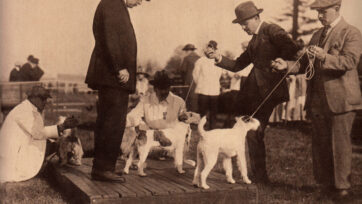[soc_one_third] content [/soc_one_third] [soc_one_third ] content [/soc_one_third] [soc_one_third class=’last’] content [/soc_one_third]
Antimicrobial (Antibiotic) Resistance in Dogs occurs when disease-causing bacteria develop the ability to resist the antimicrobial (antibiotic) drugs designed to kill them. Antimicrobial resistance is increasing to certain disease-causing bacteria that are important in canine health. This is leading to:• Infections that are difficult, and sometimes impossible, to treat;• Extended hospital stays and additional follow-up veterinary visits;• Costly alternatives, of which some have negative side-effects;• Information about your dog’s medical history, disease process and poor or lack of response to current antimicrobial therapy may lead your veterinarian to suspect a resistant infection. Only specific testing (culture and susceptibility) can confirm if resistance is present and guide effective treatment choices. Over-prescribing of antimicrobials (antibiotics) is in-part responsible for the rapid and wide-spread development of resistance. Antimicrobial stewardship (the thoughtful use of antimicrobials) by owners and veterinarians will help to reduce resistance and preserve antimicrobials so they remain useful. What is it? Antimicrobial (antibiotic) resistance occurs when disease-causing organisms, such as bacteria, develop the ability to resist the action of an antimicrobial (antibiotic). This means the bacteria are not killed by the antimicrobial medication and continue to grow. Infections caused by antimicrobial-resistant organisms are difficult, and sometimes impossible to treat. In many cases, antimicrobial-resistant infections require extended hospital stays, additional follow-up veterinary visits, and costly alternative treatments. Antimicrobial resistance is one of the biggest human and veterinary health challenges of our time. Over recent years, antimicrobial resistance has become an increasingly serious concern in veterinary medicine, having a large impact on canine health and welfare. Antimicrobial resistance has been identified in numerous species of bacteria. Those of greatest concern to canine health include Staphylococcus pseudintermedius, Staphylococcus aureus, Escherichia coli, and Pseudomonas spp. Commonly identified antimicrobial-resistant forms of these bacteria include methicillin-resistant Staphylococcus pseudintermedius (MRSP) and methicillin-resistant Staphylococcus aureus(MRSA), which are frequently identified in dogs and people, respectively. Microbiologist examining culture plates with methicillin-resistant Staphylococcus aureus bacteria. (Public Domain: Centers for Disease Control and Prevention)
Antimicrobial resistance occurs throughout the world. Some areas and populations (including dog groups) may have greater problems with resistance due to current antimicrobial use practices, lack of regulations and inattention to existing antimicrobial use guidelines (see Resources). Antimicrobial-resistant infections have been identified in many animal species and presumably all animal species and people are at risk. Individuals, including dogs and people, who are immunocompromised (immune system is not functioning properly) are at greatest risk for antimicrobial-resistant infections and especially prone to severe disease. Many antimicrobial-resistant infections occur in people. MRSP is most commonly found in dogs and MRSA is most commonly found in people. These bacteria can be passed between dogs and people, as well as other species. Some organisms, such as MRSA, primarily spread in people who then can pass them to dogs. All of the antimicrobial drug classes that we use to treat infections in dogs are also used in humans. As a result, we need to be aware of the potential impact of veterinary antimicrobial use on human health. Antimicrobial resistance that develops in our dogs can impact human health and vice versa. Transmission & Infection risk, bacteria with antimicrobial resistance typically behave the same as their counterparts that are antimicrobial sensitive (killed by commonly used antimicrobials). These antimicrobial-resistant bacteria are spread in the same ways as their sensitive counterparts. This includes spread through:• Direct contact between a dog and an animal or person infected with or carrying the antimicrobial-resistant organism;• Contact between a dog and something (e.g. environmental surface, object, clothing, hands) contaminated with the antimicrobial-resistant organism. For example this might be a dog sneezing onto the floor and later another dog licking that area of the floor and becoming infected. Signs of disease in general, signs of antimicrobial-resistant infections are identical to antimicrobial-sensitive infections. Suspicion of an antimicrobial-resistant infection includes lack of response to appropriate therapy, worsening of clinical signs while receiving therapy, and recurrent infections. Specific signs of disease vary with the disease-causing bacteria and location of infection. Some of the most common signs are those with skin and ear infections (e.g. licking, scratching at these locations), urinary tract infections (e.g. frequent, blood-tinged urination, difficulty urinating), and infection at a site where the dog recently had surgery.
Animals (and people) can carry these antimicrobial-resistant bacteria on and within their bodies (e.g. on skin; in nose, throat, gastrointestinal or urinary tracts) without signs of disease. Despite not causing clinical signs of illness, these bacteria can still be passed to other animals and people. If a dog carrying these bacteria then becomes sick, is injured or has surgery, these bacteria can cause an antimicrobial-resistant infection. Your veterinarian will diagnose an antimicrobial-resistant infection based on the dog’s history (e.g. recent use of antimicrobials), clinical signs, examination findings and confirmation through bacterial culture and susceptibility. Culture and susceptibility testing involve sending a swab or tissue sample from the affected area on the dog to a diagnostic laboratory for culture (bacterial growth). This test will determine which species of bacteria are present, if any, and their susceptibility to various antimicrobials so that the veterinarian can make the best choice for treatment. In resistant infections, a specialist in infectious disease may be consulted to assist with therapy. Based on the dog’s history, clinical disease and culture and susceptibility results, your veterinarian will prescribe the most appropriative antimicrobial. When an antimicrobial-resistant infection is identified, treatment may involve a more expensive antimicrobial, one with a higher risk of adverse effects, or a longer duration of treatment. Most often, this treatment will work, and your dog will completely recover. However, sometimes the antimicrobial may not stop the infection or there may be few reasonable antimicrobial options available. In these cases, you will need to work closely with your veterinarian to find the drug or approach that is able to successfully treat your dog or reduce the impact of the infection. In rare cases, there are no effective treatment options. In many cases, bacterial infections are secondary to another type of problem or medical concern, such as allergic skin disease, ear mites, urinary or endocrine problems. It will be important for your veterinarian to diagnose and effectively treat these primary problems to ensure that secondary bacterial infections associated with them can be successfully treated and help prevent reoccurrence. In general, dogs without clinical signs that are found to have antimicrobial-resistant bacteria present on or in their bodies should not be treated. Doing so (i.e. treating a dog without clinical disease signs) can result in an even more resistant bacteria and is unlikely to clear the organism.
We cannot completely prevent our dogs from getting an infection, or an antimicrobial-resistant infection, but there are steps we can take to help reduce these risks. • Some dogs are at a greater risk of infections than others. Talk to your veterinarian about your dog’s risks and steps you can take to reduce these in your dog. Keeping your dog healthy through proper nutrition, exercise and preventive care (e.g. vaccinations, flea/tick/worm preventives) is critical. • Be careful when and how we use antimicrobials. This includes using antimicrobials as prescribed (how much, how often and for how long) and working with a veterinarian to make these decisions. Using antimicrobials differently than instructed or those intended for a different
dog can lead to antimicrobial resistance and potentially serious health problems for your dog. When prescribed, be sure to ask what steps are being taken to ensure your dog gets the best antimicrobial for their condition and to prevent an antimicrobial-resistant infection. • Only use antimicrobials when they are indicated. Many conditions or even infections may not need antimicrobials, as they are often caused by viruses, against which antimicrobials do not work, or are self-limiting (i.e. your dog’s immune system will quickly kill the organism). Examples include mild respiratory disease (e.g. mild cough, sneezing) or diarrhea in otherwise healthy dogs. • Antimicrobials are generally discouraged when only having antibodies for a condition without clinical signs (e.g. testing positive for Lyme disease antibodies during a routine examination) – see Resources. • Know what to look for to determine if an antimicrobial is not working as expected and immediately relay this information to your veterinarian – this could be an early sign of an antimicrobial-resistant infection.
Regular hand cleaning (washing with soap and water or using an alcohol-based hand sanitizer) is one of the best ways to remove disease-causing organisms and prevent spreading these organisms to your dog or to other people. Be sure to clean hands after touching someone else’s dog, or any dog that is sick or has an infection. Be sure those at increased risk of passing disease-causing organisms to your dog (e.g. those with sick dogs, working with sick dogs such as veterinary personnel) wash their hands before touching your dog. Locations where numerous dogs come together (e.g. doggie daycare, boarding facility, groomer, breeder) or where dogs are likely to come into contact with antimicrobial-resistant bacteria (e.g. human/veterinary hospitals, nursing homes) should have an infection control program that includes animals to reduce the development and spread of antimicrobial-resistant infections. Key components of this program should include cleaning and disinfection practices, hand cleaning, prudent use of antimicrobials, removal or isolation of infectious individuals, use of clothing and barriers to protect contamination of clothing and spread of organisms (e.g. gloves, dedicated work clothing).
Depending on the bacteria species and location of the infection, in most cases dogs with antimicrobial-resistant infections should not have close contact with other animals or immunocompromised people until the infection has been successfully cured. Until cured, these individuals should not go to locations where they are likely to have contact with people at increased risk for infection (e.g. human hospitals, nursing homes) or where many dogs come together (e.g. daycare, groomers, dog parks, dog shows). If multiple dogs in a group or at an event become infected, it is recommended to immediately contact someone with experience in veterinary infectious disease risk assessment and outbreak management to help control the further spread of infection. The canine group setting’s veterinarian can provide this expertise or identify the most appropriate individual to do so. Immediately addressing such an issue is particularly important with larger dog group events and facilities such as kennels that house large groups of dogs together. An effective infection control program is critical to preventing and controlling outbreaks. Additional steps, such as reducing unnecessary dog-dog and person-dog contact are important in preventing transmission of bacteria and controlling an outbreak. Zoonotic (Human Infection) Alert: When an antimicrobial-resistant infection is identified, based on the bacteria species involved, your veterinarian or physician may recommend additional steps to reduce spread to other animals or people, especially those who are immunocompromised or otherwise at increased risk (e.g. young, elderly). These include regular hand cleaning (washing with soap and water or using an alcohol-based hand sanitizer), discouraging close contact with the infected dog (e.g. discourage kissing the dog, discourage the dog from licking people, disallowing the dog to sleep in a person’s bed) and increasing the frequency of washing dog bedding (e.g. every few days).



